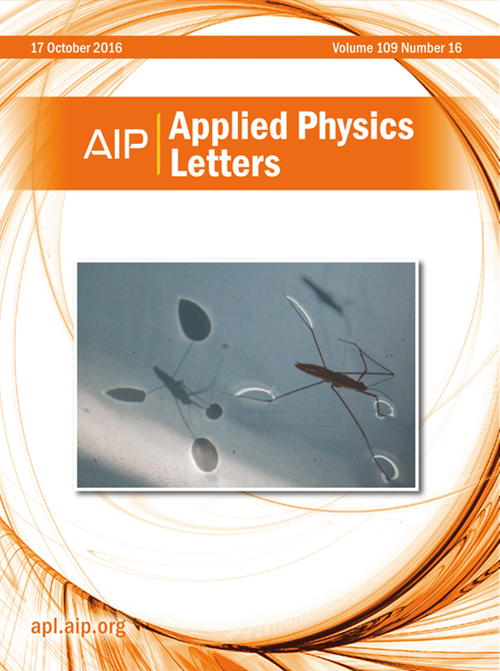Tunable acoustic delay lines based on thermally controlled single-phase unidirectional transducers
IF 3.5
2区 物理与天体物理
Q2 PHYSICS, APPLIED
引用次数: 0
Abstract
This Letter presents a tunable acoustic delay line (ADL) based on thermally controlled single-phase unidirectional transducers, fabricated on a 1 μm thick scandium-doped aluminum nitride (Al0.7Sc0.3N) thin film. The ADL operates at a center frequency (fc) of 715 MHz, determined by the lithography of the top electrode. The bottom electrode functions as a resistive structure, enabling localized heating under a DC voltage (VDC), which induces frequency shifts (Δfc) at one or both radio frequency ports. Experimental results show a maximum tuning range of 16 MHz, with a modulation efficiency of 0.2 MHz/mW, accompanied by a 3.7 dB increase in insertion loss (IL). Furthermore, the device exhibits good recovery characteristics, with both IL and 3-dB bandwidth nearly returning to their original values after removal of VDC. The integration of a heater with single-phase unidirectional transducers in this work demonstrates promising potential for applications in acoustic information processing, sensing, and signal manipulation.基于热控单相单向换能器的可调谐声延迟线
本文提出了一种基于热控单相单向换能器的可调谐声延迟线(ADL),该延迟线是在1 μm厚的掺钪氮化铝(Al0.7Sc0.3N)薄膜上制备的。ADL工作在715 MHz的中心频率(fc),由顶部电极的光刻决定。底部电极的功能是电阻结构,在直流电压(VDC)下进行局部加热,从而在一个或两个射频端口处引起频率偏移(Δfc)。实验结果表明,最大调谐范围为16 MHz,调制效率为0.2 MHz/mW,同时插入损耗(IL)增加3.7 dB。此外,该器件具有良好的恢复特性,去除VDC后IL和3db带宽几乎恢复到原始值。在这项工作中,加热器与单相单向换能器的集成显示了在声学信息处理、传感和信号处理方面的应用潜力。
本文章由计算机程序翻译,如有差异,请以英文原文为准。
求助全文
约1分钟内获得全文
求助全文
来源期刊

Applied Physics Letters
物理-物理:应用
CiteScore
6.40
自引率
10.00%
发文量
1821
审稿时长
1.6 months
期刊介绍:
Applied Physics Letters (APL) features concise, up-to-date reports on significant new findings in applied physics. Emphasizing rapid dissemination of key data and new physical insights, APL offers prompt publication of new experimental and theoretical papers reporting applications of physics phenomena to all branches of science, engineering, and modern technology.
In addition to regular articles, the journal also publishes invited Fast Track, Perspectives, and in-depth Editorials which report on cutting-edge areas in applied physics.
APL Perspectives are forward-looking invited letters which highlight recent developments or discoveries. Emphasis is placed on very recent developments, potentially disruptive technologies, open questions and possible solutions. They also include a mini-roadmap detailing where the community should direct efforts in order for the phenomena to be viable for application and the challenges associated with meeting that performance threshold. Perspectives are characterized by personal viewpoints and opinions of recognized experts in the field.
Fast Track articles are invited original research articles that report results that are particularly novel and important or provide a significant advancement in an emerging field. Because of the urgency and scientific importance of the work, the peer review process is accelerated. If, during the review process, it becomes apparent that the paper does not meet the Fast Track criterion, it is returned to a normal track.
 求助内容:
求助内容: 应助结果提醒方式:
应助结果提醒方式:


